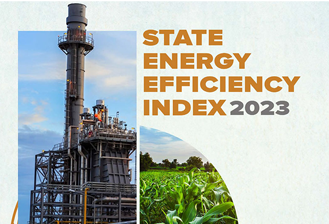India can achieve its Intended Nationally Determined Contributions (INDCs) on climate change only if each state and UT steer their climate actions and become leaders in implementing them at various local levels. Energy efficiency (EE) is crucial to India’s goal of reducing emissions intensity of its GDP by 33 to 35 percent between 2005 and 2030. To this effect, states and UTs have a strategic role to mainstream energy efficiency in their sustainable development policies. All the State Governments / UT Administrations have designated an agency as State Designated Agency (SDA) to coordinate, regulate and enforce the provisions of the Energy Conservation (EC) Act 2001 within the state.
The Global and Local Action team works to strengthen states’ institutional capacity to use data to identify and monitor energy efficiency interventions using the State Energy Efficiency Index. We promote EE as an integral part of State development policy - with other environmental, economic and livelihood goals attuned to the states’ socio-economic priorities. We support states in EE policy formulation and provide a convening platform for State Designated Agencies and Industry.
Strategic focus area
- Develop annual State Energy Efficiency Index
- Plan and strategies for energy efficiency interventions with impact on Sustainable Development Goals (SDGs)
- Enabling public and private financing for implementation
- Capacity building and awareness creation
Flagship programmes
The State Energy Efficiency Index (SEEI) is a tool designed to track EE initiatives in the states and UTs. It provides insights on sub-national energy efficiency policies, programmes, and investments. The SEEI activity was initiated by the Bureau of Energy Efficiency (BEE), in association with Alliance for an Energy Efficient Economy (AEEE), to evaluate the annual progress of EE implementation in the states. SEEI 2023 is the fifth edition of the index after the successful execution of the State Energy Efficiency Preparedness Index 2018, SEEI 2019, SEEI 2020, and SEEI 2021-22.
The SEEI 2023 assesses the performance of 36 states and UTs using 65 qualitative, quantitative, and outcome-based indicators. It is distributed across 7 demand sectors: Buildings, Industry, Municipal Services, Transport, Agriculture, DISCOM, and cross-sector.
The states and UTs are categorized into 4 peer groups based on their total final energy consumption (TFEC) to compare performances and encourage healthy competition among states.
Improving Rural Livelihoods through Energy-Efficient Cooling & Refrigeration in India
AEEE is working towards deploying low cost and low energy cooling & refrigeration technologies, understanding the grassroot level challenges, and facilitating the development of sustainable and accessible cold-chain infrastructure in rural India under its flagship project: Improving Rural Livelihoods through Energy-Efficient Cooling & Refrigeration in India, with support from Good Energies Foundation. The key stakeholders under this project are farmer producer organisations, small and marginal farmers, rural healthcare centres and small retail shops, technology providers, resource institutions in rural development, policymakers and sectoral experts.
The project is envisioned to act as a catalyst to support the Government of India’s goal of doubling farmers’ income and reducing food loss by advancing the development and implementation of efficient cold chain infrastructure. It also fosters the implementation of ICAP 2019 recommendations associated with energy efficient refrigeration technologies by promoting and adopting low-cost refrigeration technologies; and, by providing capacity building and training to technicians, farmers and other stakeholders who will be either the end-users or will operate of the deployed technology.
Project Goals, Objectives and Outcomes
The project goals are as follows:
- improved food security (SDG 2: Zero hunger)
- increasing farmers’ incomes (SDG – 8: Decent work and economic growth)
- access to better health services (SDG – 3: Good health and well-being)
- addressing climate change (SDG 13: Climate Action, SDG 7: Clean Energy)
The project objectives are centered around the use of energy efficient cooling and refrigeration solutions/technology for off-grid and weak-grid rural communities to:
- Reduce food loss through the uptake of agricultural applications such as pre-cooling, staging cold room, cold storage
- Provide cold-storage facilities in rural health centres
- Build additional income opportunities for rural productive businesses
The long-term expected outcomes of the project will be:
- Increased availability and access to low cost, low energy cooling & refrigeration solutions/ technologies for off-grid/weak-grid rural communities
- Increased interest from manufacturers for meeting the cooling & refrigeration demand in off-grid/weak-grid rural communities
- Programmes/action plans for replicating and scaling up well designed, low cost, low energy cooling & refrigeration technologies for off-grid/weak-grid rural communities
- Increased consumer awareness and labour capacity towards low cost, low energy cooling & refrigeration solutions for off-grid/weak-grid rural communities
Increasing Energy Access by Using Super-Efficient Appliances
AEEE is working towards deploying low cost and low energy cooling & refrigeration technologies, understanding the grassroot level challenges, and facilitating the development of sustainable and accessible cold-chain infrastructure in rural India under its flagship project: Improving Rural Livelihoods through Energy-Efficient Cooling & Refrigeration in India, with support from Good Energies Foundation. The key stakeholders under this project are farmer producer organisations, small and marginal farmers, rural healthcare centres and small retail shops, technology providers, resource institutions in rural development, policymakers and sectoral experts.
The project is envisioned to act as a catalyst to support the Government of India’s goal of doubling farmers’ income and reducing food loss by advancing the development and implementation of efficient cold chain infrastructure. It also fosters the implementation of ICAP 2019 recommendations associated with energy efficient refrigeration technologies by promoting and adopting low-cost refrigeration technologies; and, by providing capacity building and training to technicians, farmers and other stakeholders who will be either the end-users or will operate of the deployed technology.



